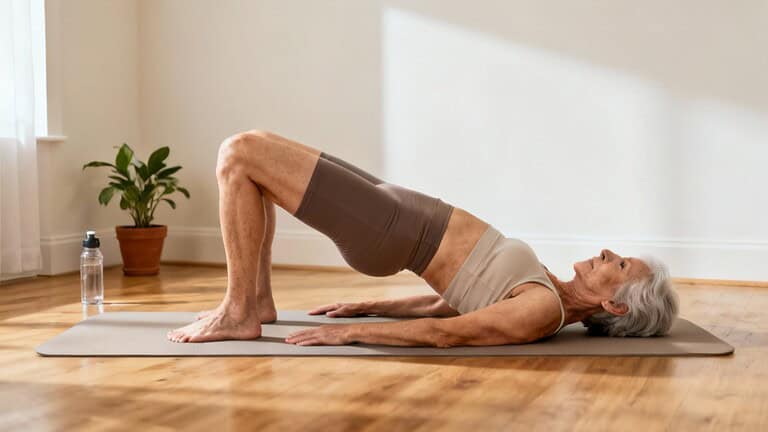If you’re over 50 and your lower back feels stiff, achy, or like it could go out any minute, I want you to hear this. It might not be your age. It might be your glutes. Yes, your butt muscles.
Most people think back pain is just part of getting older, but what if I told you that your glutes—one of the biggest, strongest muscles in your body—have quietly stopped doing their job and your back has been picking up the slack for years?
In this article, I’m going to show you why 90% of people are doing the glute bridge wrong, how that’s hurting your back, and what to do instead, using techniques I teach to clients over 50 every single day.
This isn’t just about exercise—it’s about waking up muscles that have been asleep for decades, taking pressure off your spine, and giving you that light, confident step without stretching your hamstrings five times a day or cracking your back.
The Shocking Truth: Why Most People Are Doing Glute Bridges Wrong
You’ve probably seen the glute bridge recommended in magazines, online articles, or maybe even by your physical therapist.
It looks simple: lie down, lift your hips, feel the burn. But here’s the truth—doing the glute bridge technically right doesn’t mean you’re doing it effectively.
In my experience working with people over 50, more than 90% of them do this exercise in a way that trains the wrong muscles.
That’s right—the very move that’s supposed to strengthen your hips and support your back may actually be making your back pain worse.
The glute bridge is meant to activate your gluteus maximus, the large powerful muscle in your backside that extends your hips, stabilizes your pelvis, and supports your spine.
But when your glutes aren’t firing properly—something that happens often after decades of sitting, injuries, or inactivity—your hamstrings and lower back muscles step in to do the work.
The problem is they were never meant to carry that much load. Instead of 70% of the work being done by your glutes, it flips: your hamstrings end up doing 50% or more, and your lower back takes on the rest.
That leads to tight hamstrings, aching low backs, and a sense that you’re getting weaker, not stronger.
Mistake #1: Your Foot Position Is Sabotaging the Entire Exercise
You could have the strongest willpower and best intentions, but if your foot placement is off, your glutes won’t fire, period.
And for folks over 50, where every movement matters more, this mistake becomes even more costly. Your feet are the foundation of the glute bridge.
Most people place their heels too far away from their hips. That one small detail shifts the workload from your glutes to your hamstrings—exactly the opposite of what we want. You’ll know it’s happening if your hamstrings cramp or burn before your glutes even wake up.
How to Fix It:
Lie on your back and bring your heels close enough that your fingertips can just touch them. This simple cue helps align your body so the glutes are in a position to activate.
For many of my clients over 50, just making this small adjustment leads to a noticeable difference right away.
But there’s more. How your foot presses into the ground also matters. Instead of just thinking “lift your hips,” I want you to focus on three pressure points under your foot:
- Your heel
- The outer edge of your foot
- The ball of your big toe
This tripod foot pressure distributes force evenly and helps keep your hips aligned during the bridge. People often shift too much weight to the outer foot, which disengages the inner thigh and short circuits glute activation.
Try this before lifting your hips: press all three points of your foot into the ground and imagine pushing the floor away. You might be surprised how much more stable, balanced, and glute-driven your movement feels.
Mistakes #2 & #3: The “Too Much” Problem
Let’s talk about your spine because in the glute bridge, what your back does is just as important as what your hips do. And for those of us over 50, spine alignment isn’t just about form—it’s about long-term protection.
Two of the most common and dangerous mistakes I see are:
- Overtucking the pelvis, flattening the lower back too much
- Overarching the back at the top of the lift, going too high, and flaring the ribs
Both are subtle. Both feel normal. And both can slowly wear out your lower back if left unchecked.
Mistake #2: The Overtuck
A slight posterior pelvic tilt (tucking your tailbone) can help engage your glutes, but too much tucking removes your spine’s natural curve. That’s like walking around with your hips locked under you—not good for balance or long-term spinal health.
Instead, start with a neutral spine. Press the small of your back gently into the floor, just enough to feel connected, not smashed.
Mistake #3: Lifting Too High
This is a big one. Many people think higher is better, but if your ribs flare or your lower back arches at the top, you’ve gone too far. The proper height: imagine drawing a straight line from your knees to your shoulders. That’s it—no Olympic back bend required.
Pro tip: try exhaling as you lift. It helps keep your ribs down and engages your core. If you feel tension in your low back instead of your glutes, you’re lifting too high or losing form.
The Wakeup Call: How to Reactivate Sleeping Glutes
You’ve adjusted your feet. You found your spine sweet spot. But there’s one final piece that makes or breaks the glute bridge: can your glutes even hear the message your brain is sending?
For many of us over 50, the answer is not clearly. Years of sitting, injury, or underuse can lead to a condition informally known as gluteal amnesia. Your brain literally loses the connection to your butt muscles. They’re still there, but the signal’s gotten fuzzy.
Luckily, we can reboot that connection using a powerful but simple tool: BOF feedback through touch.
How to Reactivate Your Glutes:
- Lie in your bridge starting position
- Place your fingertips lightly on your glutes—not too low (you’ll hit hamstrings), not too high (that’s your lower back)
- Without lifting your hips, try to contract your glutes. Just squeeze
- If you don’t feel anything, use your fingers to press gently into the muscle and imagine trying to push back against them
- Hold for a few seconds, then relax
- Repeat 10-15 times, staying focused
This tactile feedback does two powerful things: it brings awareness to the glute (your brain knows where to send the signal), and it improves motor control (your body relearns how to isolate and fire the right muscle).
Over time, this repatterning allows your glutes to lead the movement again—not your hamstrings, not your back.
Who Should Not Do Glute Bridges?
Glute bridges are safe for most people over 50, but not everyone. If you’re experiencing acute lower back pain, sciatica flare-ups, recent spinal or hip surgery, or severe osteoporosis, this movement may place unnecessary stress on healing tissues.
Also, if lying flat causes discomfort or dizziness, pause and consult your healthcare provider. Remember, activation is different from aggravation. This exercise is meant to restore function, not force it.
When in doubt, get cleared by a physical therapist first. You’ll get better results and peace of mind by starting from where your body actually is, not where you wish it were.
The Bridge Back to Strength, Stability, and Confidence
If you’ve made it this far, take a moment to appreciate yourself. You didn’t just learn how to do a glute bridge—you learned how to reconnect with one of the most powerful muscles in your body. And more importantly, how to move with intention, not just habit.
For too long, people over 50 have been told to expect weakness, stiffness, and pain as part of aging. But the truth is, your body hasn’t given up on you. It’s just waiting for better instructions.
By now you understand that it’s not just about lifting your hips off the floor. It’s about activating your glutes with precision, stabilizing your spine with awareness, and breaking old movement patterns that don’t serve you anymore.
When your glutes start firing properly, everything changes. Your steps feel lighter. Your back feels more supported. Even everyday tasks like getting out of a chair or climbing stairs become smoother.
This isn’t just a fitness tip—it’s a gateway back to functional independence, which is what truly matters as we age.








